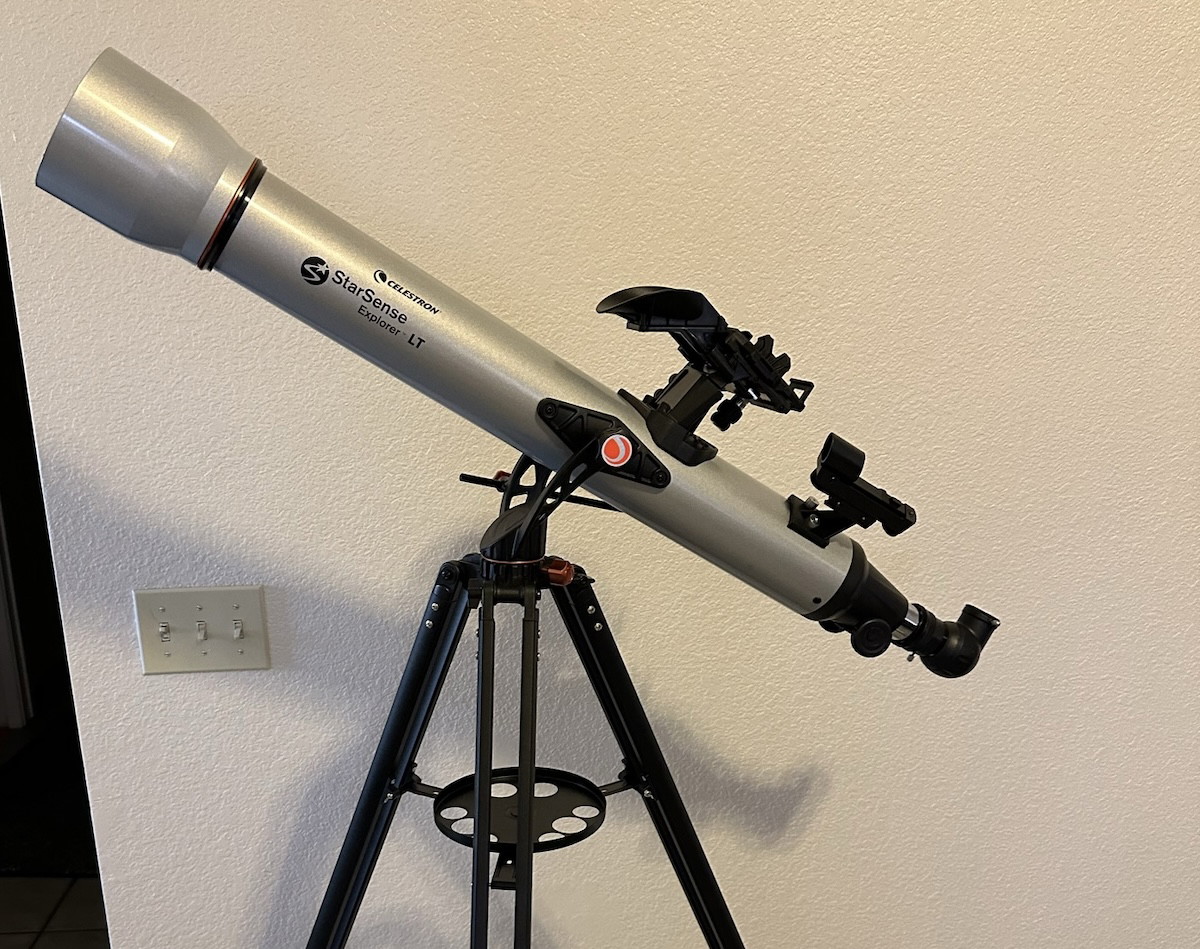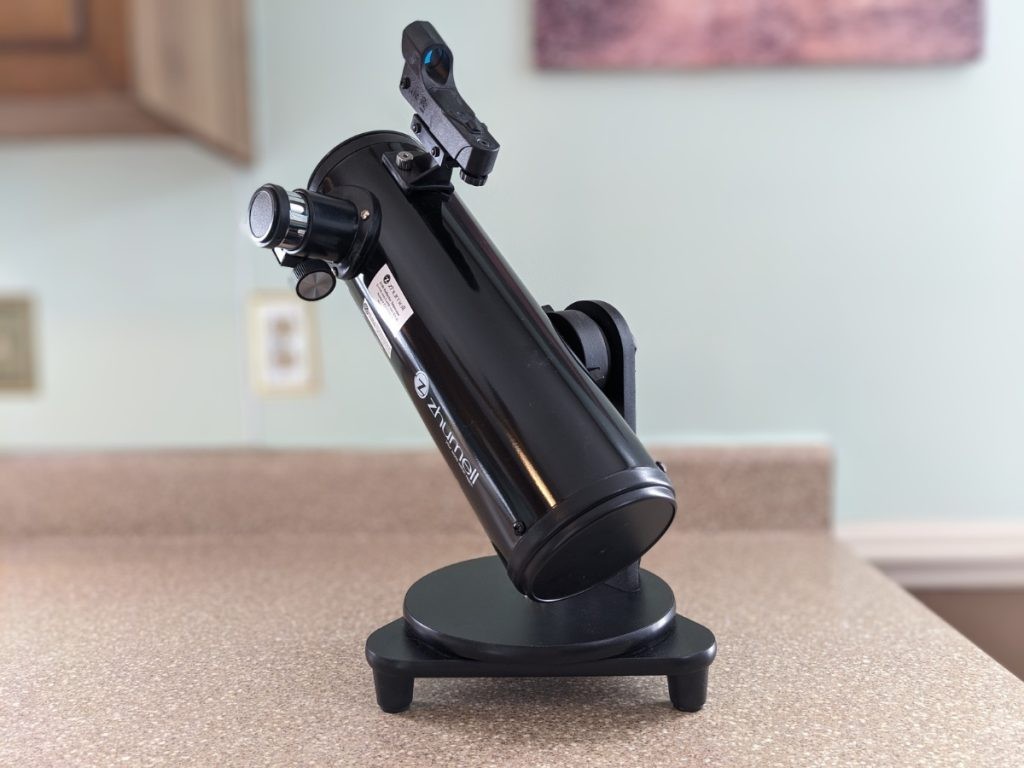When I do public outreach, either at the Observatory, at star parties, or when doing sidewalk astronomy, a common question I get when people see my “huge!” (really mid-sized) 6” Dobsonian telescope, or my “ENORMOUS!” (really just big) 10” Dobsonian telescope, is “how much does something like that cost?” People are often shocked by the answer.

I remember one conversation I had with a group who had stopped, coming out of the gas station I was set up at. I was showing them the Moon with my 6-inch telescope, and they asked, “How much did you pay for that?”
I told them, “About three hundred.”
“Three hundred thousand!?” They exclaimed.
“Three hundred dollars,” I calmly corrected.
Telescopes, as it turns out, are pretty affordable, actually. A lot of people think a big telescope will cost no less than a thousand dollars, and while it is very easy to spend about that much or more if you have that budget, there are certainly beginner-friendly, budget-friendly options available.
What is a “good telescope?”
If you take a look at the rating scheme we use for telescope reviews on this website, you’ll see that there are several important aspects of a telescope, but what our rating scheme lacks (intentionally) is perhaps the most important spec of the telescope: aperture. Aperture is the size of the light-gathering element of the telescope, called the objective.

See, the primary purpose of a telescope is not to magnify. It’s to gather light. The more light you gather, the brighter the image will be.
The secondary function of a telescope is to increase the resolution of a target, so when you do magnify it, you’ll see it at a higher detail.
Because light is just as much a wave as it is a particle, it ripples around the edge of the objective. The larger the opening, the more light gets through without rippling. The result is that a larger telescope will show smaller dots when looking at a point source of light, so the telescope has more “pixels,” if you will, to assemble the image out of.
All else being equal, the best telescope is the one with the largest aperture to let in the most light. Now, in practice, other things must be taken into consideration, like secondary obstruction and optical flaws like chromatic aberration and spherical aberration, which plague cheaper telescopes. But otherwise, if you have two nearly identical telescopes and one’s bigger, you want the bigger one.
But aperture isn’t everything. Ease of use and portability are important, and the cost of telescopes is an issue as well.
A good telescope could mean different things to different people:
- Are you looking for a beginner telescope to only get a passing familiarity with the night sky with the assumption that you’re soon going to upgrade to bigger and better things?
- Or are you looking for a “forever telescope,” a telescope that, though it may make certain compromises, you will be reasonably happy with for a long time?
- Or perhaps something in between, where you might want to upgrade one day but you still expect it to be a serious instrument?
Each of these corresponds, essentially, to a set of apertures.
- For a good beginner telescope you may eventually grow out of (or want to supplement, at least), that would fall within the 3” to 4.5” range of apertures. There are many high-quality instruments, even in the affordable beginner price range, within this set of apertures. In fact, if you aren’t an astronomy fanatic, some of these may be the only telescopes you’ll ever need.
- For a genuinely good telescope, which even an astronomy fanatic will take a while to tire of, telescopes in the 5”-6” category (or maybe an 8” for someone with aperture fever) fit the bill. This includes either extremely expensive refractors, mid-priced Schmidt-Cassegrains and Maksutovs, or very affordable Newtonian reflectors like the Dobsonians.
- For a forever telescope, you’re going to want something in the 8” to 12” range. Virtually the only telescope types that big are Dobsonians and SCTs.
How much you can expect to pay for a telescope of a given aperture depends greatly upon which type you get. Refractors are generally the most expensive (except in the cheap “hobbykiller” price bracket, where there are few reflectors to compete), followed by Schmidt-Cassegrains and Maksutov-Cassegrains, followed by cheap but effective Newtonian reflectors.
And, How Much does a Telescope Cost?
It depends. Of course, it depends. You didn’t think this was going to be an easy, straight answer with a question as vague as that, right?
In most of our articles, we remain somewhat agnostic on the specific dollar amounts and prefer to speak about the relative prices of telescopes within a price range. Due to the question, we kind of have to use the actual dollar amounts, or something close to them, to answer the question. Just keep in mind that telescope prices are not constant.
The Cost Territory of “Hobby Killers”
There are several telescopes available in department stores, on Amazon, and on eBay for under $100. Perhaps $50-80. The vast, vast majority of these are garbage. We call them “Department Store Refractors” or even “Hobby Killers.”
In the past decades, these usually took the form of long, thin tubes on spindly little tripods, though we’re now starting to see more short, fat tubes on spindly little tripods. Invariably, the mount/tripod and accessories are garbage and not worth using.
On rare occasions, a telescope with genuinely good optics will shine through, but usually at an aperture that’s just a little too small to be interesting to use and usually with a terrible mount that is nearly impossible to use effectively.
The Cost of Acceptable Telescopes

A 3” achromatic refractor such as the Celestron StarSense Explorer LT 80AZ costs $200. Though there are many 3” refractors in that price range, the mounts in most of them are generally cheap and finicky.
The Zhumell Z100 is a 4” f/4 Newtonian reflector on a Dobsonian mount. A few years ago, its price was only $100, but now it is $150-$200.

For some time, I have lauded Zhumell Z100 (and the now non-existent Orion SkyScanner 100) as a great “bare minimum” telescope. For a very low price, you could have a telescope that would show you the rings of Saturn and banding on Jupiter at least as well as a generic department store refractor, but would show relatively bright images of deep-sky objects at a low magnification, wide field of view.
It’s mirrors is technically paraboloids, but they’re not figured to a high degree of precision, so they are not diffraction-limited, meaning they don’t perform as well as a 4” reflector should be able to. Because its mirror isn’t diffraction limited and it lacks collimation adjustments, I still consider it to be something of a toy, but it’s a very good toy, and one that would keep children and adult observers busy for some time while they learn the night sky.
I often use mine even when I have larger instruments available, as it’s a good, portable, grab & go instrument. So even if you end up with a larger telescope eventually (and odds are, you will eventually want a larger telescope eventually), it will still have a niche.
A slightly larger (but about a hundred dollars more expensive) telescope can be found in the Zhumell Z114. It has a 4.5” mirror, but they’re diffraction limited, meaning that if you align the mirrors (a process known as collimation), it will provide sharp, high-magnification views up to about 200-230x magnification when used with the right eyepieces (high-power eyepieces are sold separately–expect to pay another $30-60 for a good one). This is a good telescope and it costs $230-280.
The Cost Of Good Telescopes

Once again, telescope rates are subject to change, but you can expect to pay no less than $300, and these days more like up to $500, for a 6” Dobsonian telescope. Any of the 6” Dobsonians are pretty good.
Perhaps the best two deals on the market right now, as of writing, are the SkyWatcher Heritage 130P and SkyWatcher Heritage 150P, 5” and 6” Tabletop Dobsonians. You can expect to pay $250–300 for that, which is barely more than what you would have paid a few years ago.
8” Dobsonians go for a minimum of about $500, generally around $600+. 10″ and 12″ Dobsonians can cost up to and beyond $1000 at times.
It is now cheaper to build a 6” or larger telescope from scratch (including the mirrors; it’s easier than you think) than to buy one. For much of the last decade, amateur telescope making was seen as a dying hobby, but with telescope prices as they are now, you can save a lot of money if you build a telescope from scratch without sacrificing much performance. You could make an 8” Dobsonian for perhaps as little as $300, but it’d be a lot of work. 3D printing is also helping to revolutionize this hands-on subset of the hobby.
- Here’s a link to a Stellafane guide on how to figure a telescope mirror
- Here’s a link to a Stellafane guide on how to build a dobsonian telescope from scratch.
The Cost of REALLY good telescopes
This is perhaps the most arbitrary category of all. See, some people will want computerized systems to do the work for them, or they will prefer to maximize light gathering. Or they will settle for a smaller aperture but one with superb optical quality in the form of an apochromatic refractor.
The trouble is that telescopes are always a compromise. Any improvement you make somewhere is going to have some downside. There’s no perfect instrument, and paying a lot more money for a product might only represent paying for a product that was harder to make, not one that is truly better.
Is a 3” Apochromat with absolutely perfect optics on a computerized go-to mount really better than a 12” Dobsonian, which you crudely shove around, but can see countless more objects with? Perhaps it is if you’re interested in astrophotography or if you want a very compact setup that is easy to carry around but maximizes quality for the budget you have.
Truth be told, I think most people, and certainly any beginner, will be very impressed with something as simple as an 8” Dobsonian telescope. Go-to scopes have their own set of compromises, beyond merely the additional cost. So, at current prices, the cheapest REALLY good telescope could be as low as $600.
But suffice it to say that it is possible to spend many thousands of dollars on equipment, optical tubes, mounts, and even home observatories. Astronomy can be as much of a money sink as you want it to be (and can afford it to be).
